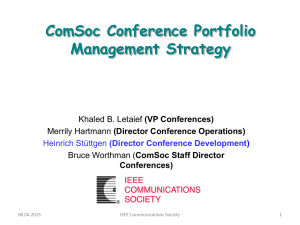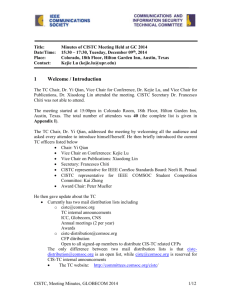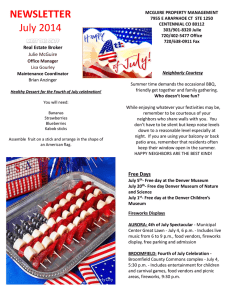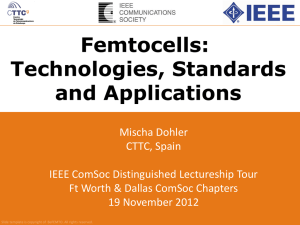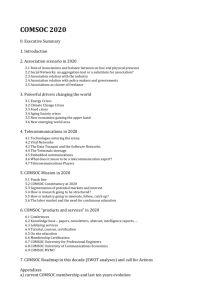Joint Quality and Error Control Coding for DNA Microarrays
advertisement
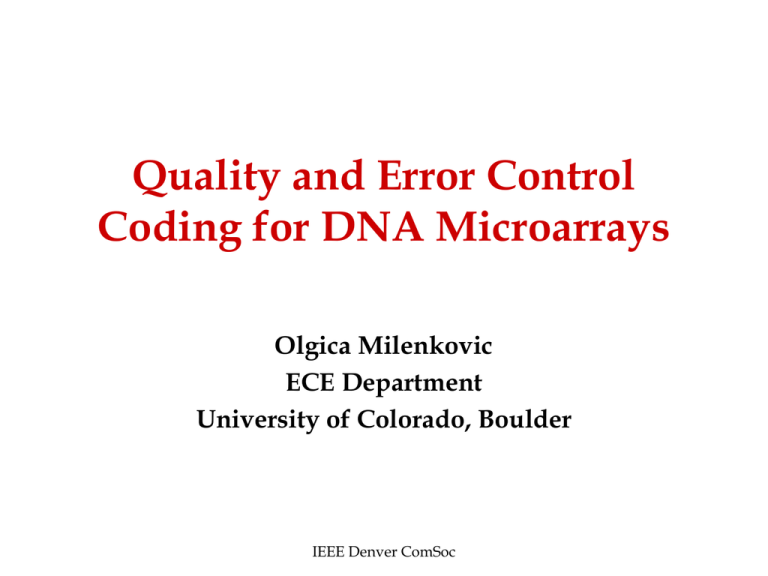
Quality and Error Control Coding for DNA Microarrays Olgica Milenkovic ECE Department University of Colorado, Boulder IEEE Denver ComSoc Outline • DNA Microarrays • VLSIPS (Very Large Scale Immobilized Polymer Synthesis) • Production of DNA Microarrays (http://www.affymetrix.com/) – Base Scheduling – Mask Design – Quality-Control Coding • Error-Correcting DNA Microarrays (Multiplexed Arrays) • Production of Multiplexed DNA Microarrays – Base/Color Scheduling – Mask Design – Quality-Control Coding IEEE Denver ComSoc DNA microarrays I Slide #1 Goal: Determining which genes are expressed (active) and which are unexpressed (inactive) Comparative gene expression study of multiple cells Transcription Translation Control of Transcription & Translation Transcription Translation Protein Coding Sequence Protein Coding Sequence Protein Protein Gene expression and co-regulation IEEE Denver ComSoc DNA microarrays II Slide #2 Creating the `cell cultures’ to be compared… `Green’ Cell Culture : `Red’ Cell Culture: DNA Subsequence 3’- AATTT CGC… - 5’ DNA Subsequence 3’- AATTT CGC… - 5’ mRNA 5’ - UUAAAGCG… - 3’ mRNA 3’ - UUAAAGCG… - 5’ cDNA 3’ - AATTTCGC… - 5’ cDNA 3’- AATTT CGC… - 5’ “Color Coding” 3’ - AATTTCGC… - 5’ “Color Coding” 3’- AATTT CGC… - 5’ Creation of tagged cDNA sequences from first cell type Creation of tagged cDNA sequences from first cell type IEEE Denver ComSoc DNA microarrays III Spots Slide #3 Gene Probes Complementary sequences hybridize with each other, forming stable double-helices Hybridization: 3’-AAGCT-5’ 5’-TTCGA-3’ DNA microarray is scanned by laser light of different wave-lengths IEEE Denver ComSoc Probe synthesis in microarrays I VLSIPS (Gene Chip, AFFYMETRIX, Array Manufacturing Manual) Linkers Mask Quartz Wafer Linker Activation IEEE Denver ComSoc Slide #4 Probe synthesis in microarrays II VLSIPS (Gene Chip, AFFYMETRIX, Array Manufacturing Manual) Solution of one DNA base (A or T or G or C) Solution of one DNA base (A) IEEE Denver ComSoc Slide #5 Slide #6 Base scheduling I Fixed probe length: N Production steps ATGC ATGC ATGC ATGC Spots Synchronous 1 schedule 2 (length 4N) 3 4 CTGA 5 ACAA IEEE Denver ComSoc Slide #7 Base scheduling II Production steps AGGC TTGC TTGC CCGC Spots 1 2 Asynchronous schedule 3 4 5 IEEE Denver ComSoc Base Scheduling III Slide #8 • Shortest asynchronous base schedule – Shortest common super-sequence of set of M sequences (NP-hard) ESN(M,k) – expected length of a longest common subsequence of M randomly chosen sequences of length N over an alphabet of size k k( l ) lim N k( M ) ES N ( M , k ) N M log(z0 k ) log(k(( 1 z0 ) M 1 )) z0 21 / M 1 No significant gain for N≈20-30 Periodic schedule used instead (length 4N) IEEE Denver ComSoc Mask Design Slide #9 Border-length minimization Feldman and Pevzner, 1994 Hannehalli et.al., 2002 Kahng et.al. 2003, 2004 Key idea: Arrange the probes on the array in such a way that the border-length of all masks is minimal Border-length graph: complete graph on M vertices, weight of edges equal to the Hamming distance between probes Greedy traveling salesman algorithm+ threading (discrete space-filing curve) IEEE Denver ComSoc Quality Control Slide #10 Hubbell and Pevzner, 1999 Sengupta and Tompa, 2002 Colbourn et.al., 2002 Quality control (fidelity) spots Manufacture identical probes at several quality-control spots in order to test precision of production steps IEEE Denver ComSoc Relevant coding-theoretic ideas Slide #11 Balanced code (Sengupta and Tompa, 2002): An b×v binary matrix of zeros and ones with • each row has weight k; • each column has weight bounded between l and b-l, for some constant l; • any pair of columns is at least at Hamming distance d apart; Superimposed designs in Renyi’s search model (Kautz and Singleton, 1964, Dyachkov and Rykov, 1983): An b×v binary matrix of zeros and ones with • all Boolean sums composed of no more than s columns are distinct; •each row has weight exactly t; Additional constraints: the Boolean sums form an error-correcting code with prescribed minimum distance d; IEEE Denver ComSoc Slide #12 Error-correcting microarray design • Probe multiplexing (Khan et.al, 2003) Probes Excluding hybridization effects, spot formation quality and under iid measurement noise, min tr(G* T G* ) G* ( G T G ) 1 G T n k 0 1 G matrix, n k rank( G ) k 0 1 0 G 0 1 1 1 0 0 1 0 1 1 1 1 0 0 0 0 0 1 1 1 0 G( i , j ) c const. j X – vector of RNA levels corresponding to N genes Y – total concentration of RNA at all spots Y TGS X S - hybridization affinity matrix, T - spot quality matrix Decoding algorithm: numerical optimization IEEE Denver ComSoc s p o t s VLSIPS/analysis for multiplexed arrays Slide #13 Features: • Multiple polymer synthesis at one given spot (for simplicity, will consider only two probes per spot) • Can use two different classes of linkers sensitive to different wavelengths so to select probes for extension (say, `blue’ and `green’ and `cyan’) Spots A T G C A T G C g b c c A T G C A T G C g g c b g b g 1 2 3 4 5 6 g b b c b Slide #14 VLSIPS/analysis for multiplexed arrays Scheduling: shortest schedule of bases/colors (Using results from V. Dancık, Expected Length of Longest Common Subsequences, 1994) Set-up: two identical sets of M `blue’ and M `green’ randomly and uniformly chosen sequences of length N over the alphabet of size four Length of shortest schedule lim 2 4( M ) 4( M ) ( 2 4( M ) 1 ) N Chvatal-Sankoff constants Synchronous schedule, no `cyan’ colored steps: 8N IEEE Denver ComSoc Mask design: A C G T A C G Slide #15 T S1 AT,CA S2 AC,CC S3 GT,GA S4 TT,TA b g c c g c c b s1 s4 s3 s2 L(M)=4, L(M)=4, L(M)=2, L(M)=2, L(M)=2, L(M)=2, L(M)=2 L(M)=2, L(M)=2, L(M)=2, L(M)=2, L(M)=2, L(M)=2, L(M)=2 s1 s3 s2 s4 Mask Design / Scheduling Slide #16 Neighborhood graph: complete graph with M vertices labeled by two distinct sequences ( p ( ), p ( )) 1 2 No `cyan’ steps: weight of edge between two vertices ( p1 (1 ), p2 (1 )), ( p1 (2 ), p2 (2 )) sums of Hamming distances Issues: For reasons of controlled hybridization, different probes (blue and green) at the same spot should have fairly large Hamming distance (Milenkovic and Kashyap, 2005) Border-length minimization becomes less effective With cyan colored steps involved, the distance measure also depends on the longest common subsequence of the probes at the same spot IEEE Denver ComSoc Quality Control Coding Slide #17 Theorem: Assume that there exists a linear error-control code with parameters [n,k,d] containing the all-ones codeword. Then one can construct a quality control array for a multiplexed DNA chip with 2(2k-2) disjoint blue and green production steps and M probes such that the length of each quality control probe is 2(k-1)-1, and that the weights w of the columns in the quality control array satisfy d wnd Furthermore, with such an array any collection of less than n/(n-d) failed blue or green steps, respectively, can be uniquely identified. Open question: how does one extend this result for schedules involving `cyan’ colored production steps, and under `spot’ failures. IEEE Denver ComSoc


